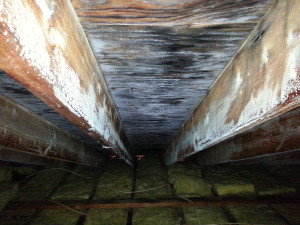Why be Concerned about Mold in the Attic?
We frequently are asked to remove mold from a residential attic. There is little doubt that it occurs under certain conditions. Is it, however, a health hazard?
It is useful to remember the air dynamics of any building, including your home. Warm air rises and you can try to stop it but you won’t. Starting from the basement, air is heated, either by winter time heating or just plain hot weather, and moves upward. This convection forces air out of the basement and eventually the air arrives in the attic.
The reason that we ventilate an attic is to release the air, and attendant moisture t
hat it has absorbed, so that it does not accumulate in the space. Back in the day, this was pretty straight forward, since there were not many moisture sources in the home that added to the moisture load. A couple of gable vents were usually sufficient to vent the air (and moisture).
Fast forward to the present and there are many more moisture sources to manage. Just a simple thing as replacing clapboard or asbestos siding with vinyl changes the whole ventilation dynamic of the home. Vinyl is impermeable and the air that used to get to the home and attic does not. The home no longer breathes the way it used to.
Then add some moisture in the form of the humidifier on the HVAC unit. It seems like a good idea to make the living space more comfortable in the dry winter months. But you must appreciate that you are adding an (unknown) amount of moisture into the home that ends up in the (guess what) attic. And because it is winter, the attic roof deck is cold and will condense that moisture. You end up with mold growth on the roof deck.
Another common issue is a bathroom or dryer exhaust fan that discharges not outside, but into the attic. So we add moisture into the attic just because we couldn’t bring ourselves to run the vent outside. This is a surprisingly common cause of attic mold.
So what should you do? My first suggestion is to turn off the humidifier and acclimate to the dryer winter environment. If you need moisture, provide it with local humidifiers that you can keep an eye on. And please do not vent your bathroom fans into the attic.
Also take a look at the ventilation in the attic. The combination of ridge and soffit vents is a great way to increase ventilation naturally and continuously. This assumes, however, that there are actual soffit vents. Often, especially when we have vinyl siding, we assume that all those holes in the soffits are actual vents. You have to look above them, however, to determine whether the original plywood soffits are open. Usually they are not.
And a word about attic fans. Virtually all fans are designed to perform when it is hot, meaning during the summer. They usually do not operate during the winter. But the winter is when condensation is likely to occur on the cold roof deck. In the summer, it is frequently too hot for condensation of any type to occur. In addition, most homeowners don’t regularly inspect their attic and wouldn’t know if there is a mechanical failure of the fan. So fans are wonderful, but you need to consider a ventilation solution that is year round. Hint, hint: ridge and soffit vents.
So I have two answers to the question of whether mold in the attic is a significant issue. On the one hand, the natural convection of air reduces the communication between the attic and living spaces. Exposure to mold is unlikely. On the other hand, visible mold growth is going to be a problem on the sale of the home. It would be prudent, therefore, to address the ventilation issues now. Lose the humidifier and consider soffit and ridge vents. This problem is then solved.